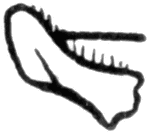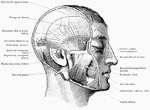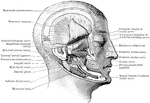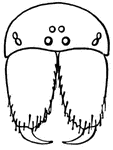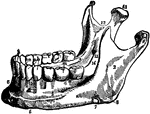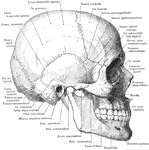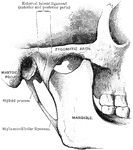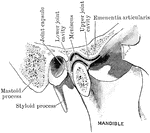Clipart tagged: ‘mandible’

Alimentary Canal of a Bird
Alimentary canal of a bird. Labels: a, ingluvies; b, proventriculus; c, pancreas; d, duodenum; e, liver;…
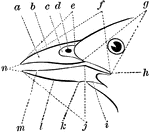
The Parts of a Bird Bill
"Fig. 26 - Parts of a Bill. a, side of upper mandible; b, culmen; c, nasal fossa; d, nostril; e(see…
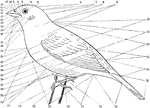
Topography of a Bird
"fig. 25 - Topography of a Bird. 1, forehead (frons). 2, lore. 3, circumocular region. 4, crown (vertex).…
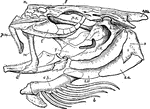
Cod Skull
"The skull of a cod. b, branchiostegal rays born on c.h., the ceratohyal bone; d, dentary portion of…

Dog Skull
"Longitudinal and Vertical section of the skull of a dog, with mandible and hyoid arch. an, anterior…

African Elephant Skeleton
"Skeleton and Outline of African Elephant (Elephas or Loxodon africanus). fr, frontal; ma, mandible;…

Skull of a Common Fowl
"Fig. 62 Skull of common fowl, enlarged. from nature by Dr. R.W. Shufeldt, U.S.A. The names of bones…

Head Showing Deep Mastication Muscles
A deep view of the muscles of mastication. The zygoma and masseter muscle are removed.
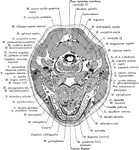
Cross Section of Head Through the Body of the Mandible
Section of the head through the body of the mandible.
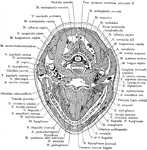
Cross Section of Head Through the Inferior Portion of the Mandible
Section of the head through the inferior portion of the mandible.
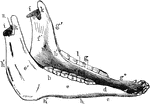
Inferior Maxilla of a Horse
Inferior maxilla of a horse-anterolateral view. Labels: a, body; b, b', rami; c, neck; d, mental foramen;…

Jaw at Birth
The lower jaw at birth. A, As seen from above. B, As seen from outer side. C, As seen from inner side.…

Jaw Showing Roots of Teeth
Horizontal section through both the upper and lower jaws to show the roots of the teeth. The sections…

Norway Lobster Appendages
"Appendages of Norway lobster. Ex., Exopodite: En., endopodite; protopodite dark throughout; Ep., epipodite.…
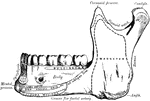
Mandible
The mandible is the largest and strongest bone of the face. It serves for the reception of the lower…

Mandible of a Rabbit
Lateral half of mandible of a rabbi, opened to show the arrangement of rodent teeth.

Mosquito Head
"The head of female mosquito (culex). a, antenna; c, clypeus; h, hypopharynx; m, mandibles; ma., maxillas;…

Mylohyoid Muscle
Shown is the mylohyoid muscle. The mylohyoid muscle is a flat, triangular muscle situated beneath the…
Proboscis
"Diagrammatic vertical section of the head and proboscis of a mosquito. l, labium bent as when the other…
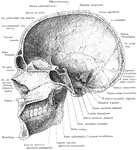
Median Section of the Skull and Mandible
Median section of the skull and mandible, viewed from the left.

Stag Beetle
"The largest European species of beetle an adult male sometimes reaching an length of over two inches,…

Teeth
To show the relation of the upper to the lower teeth when the mouth is closed. The manner in which a…

Thysanuran
"A typical Thysanuran (Machilis maritima). Female, ventral view. Mx1, Mx2, 1st and 2nd maxillae. ii-x,…
